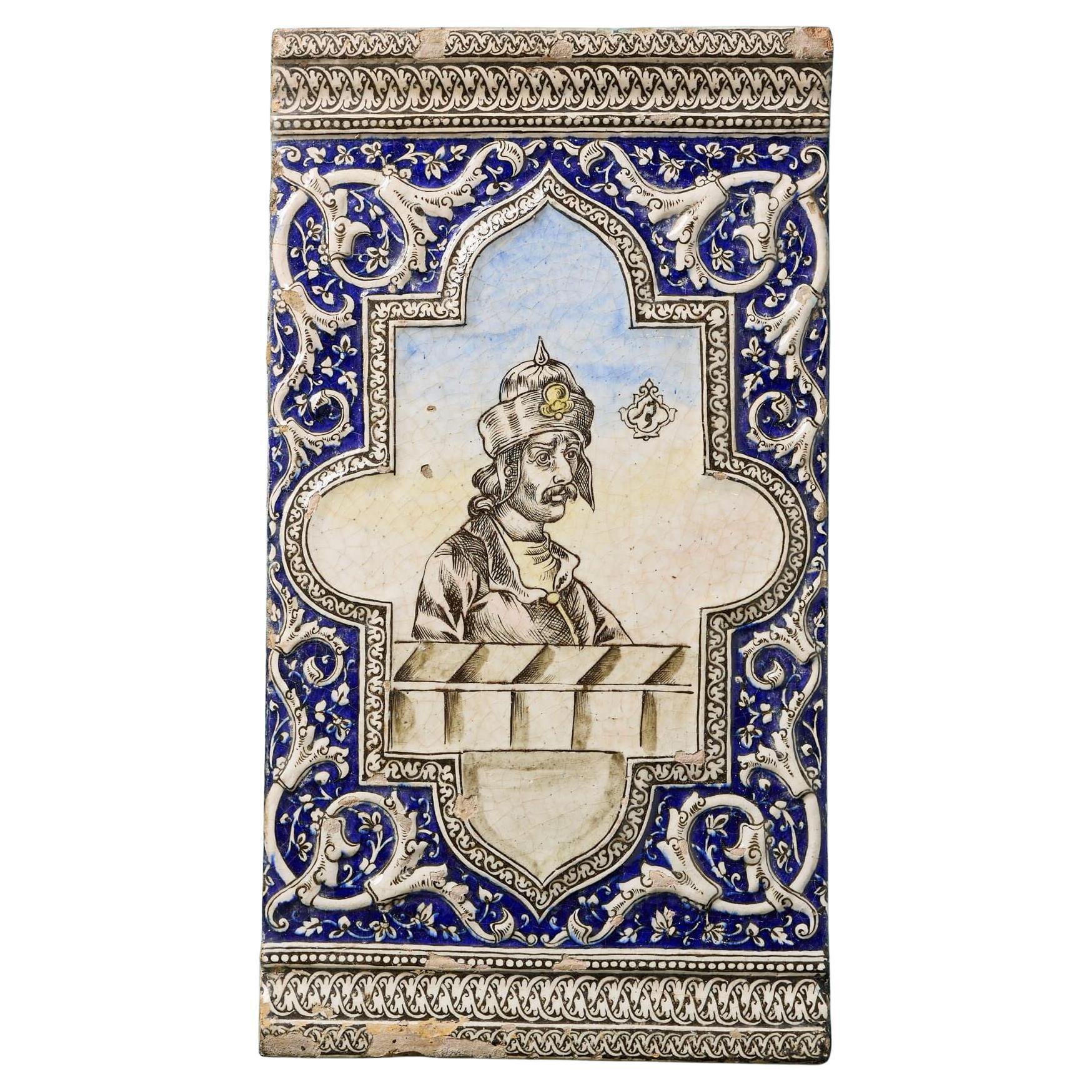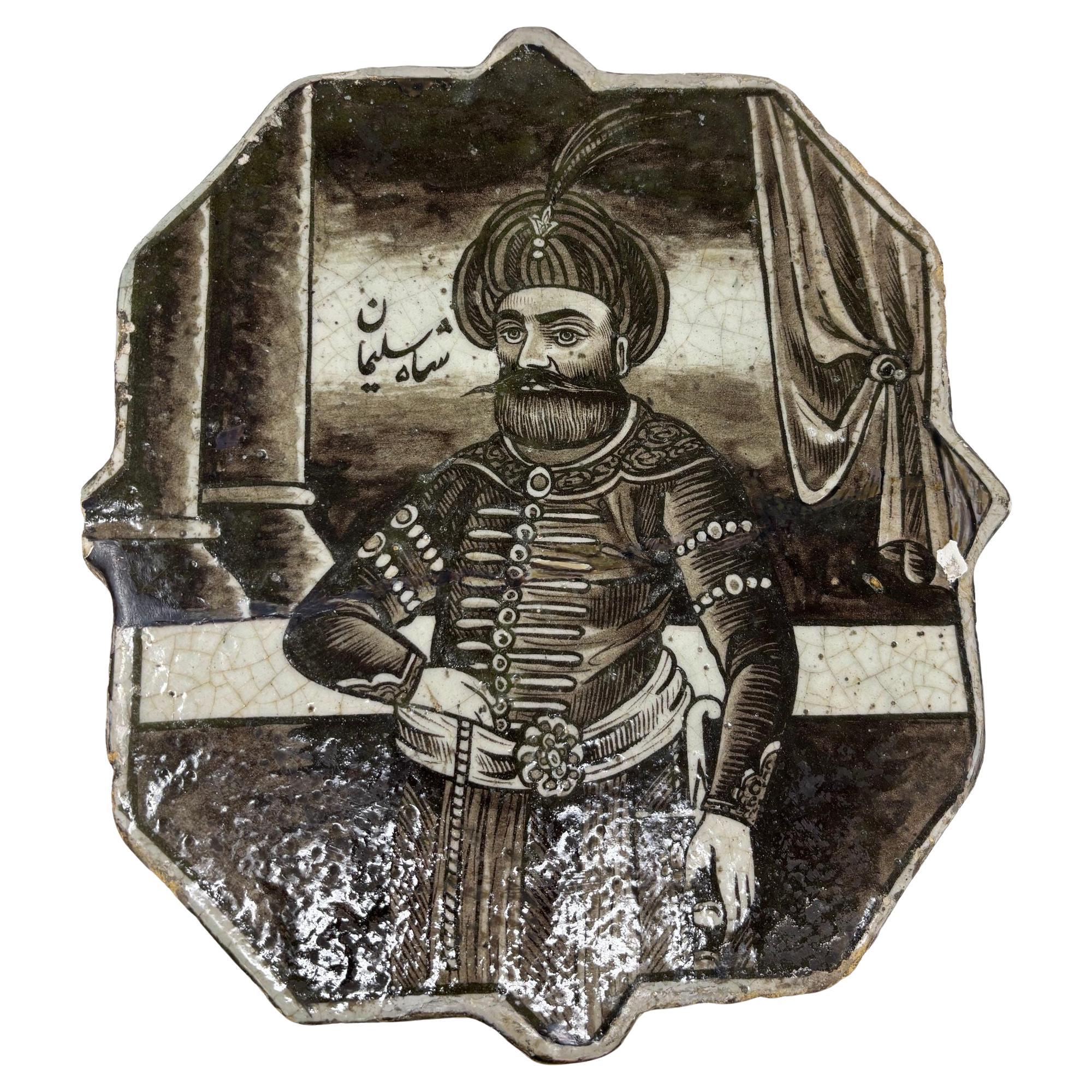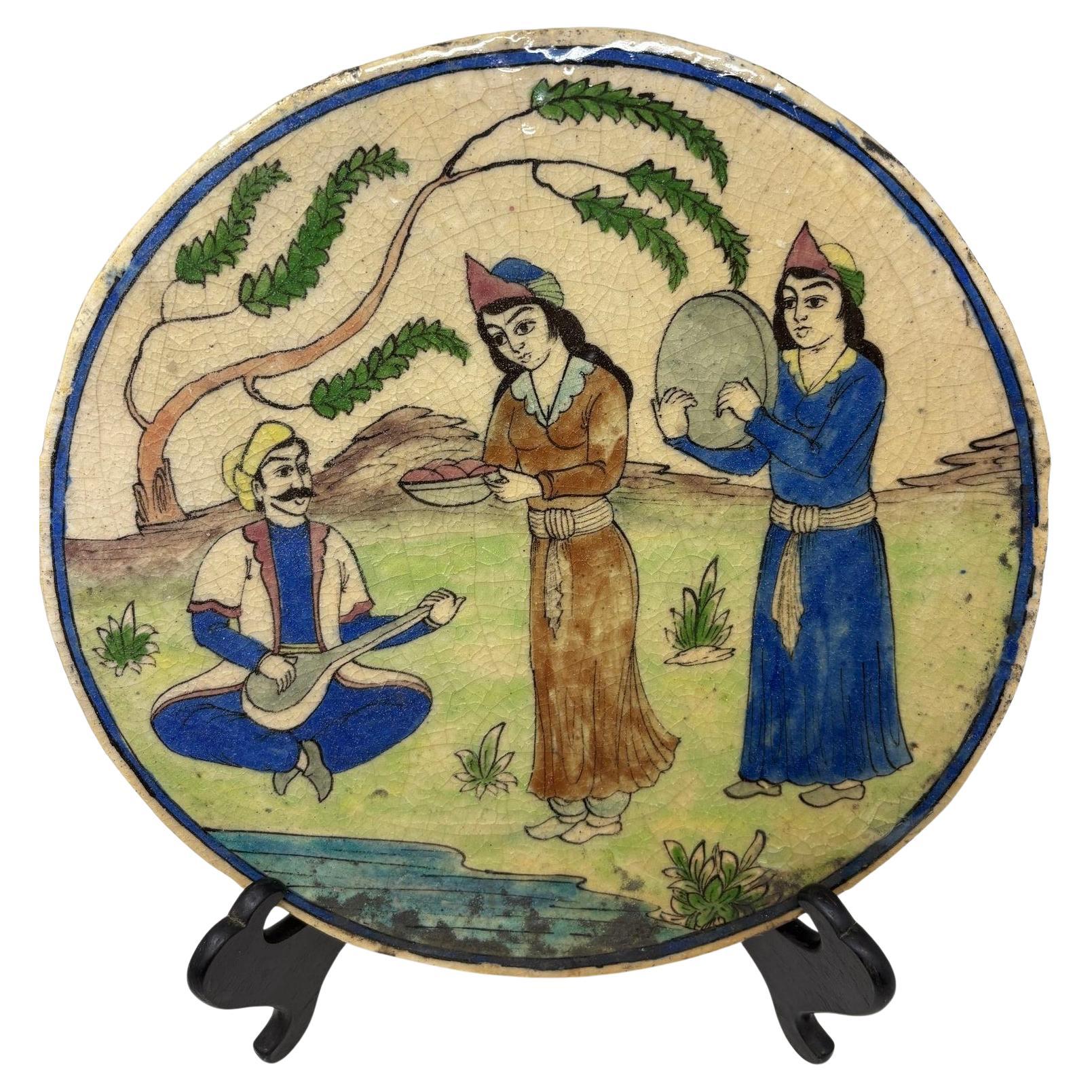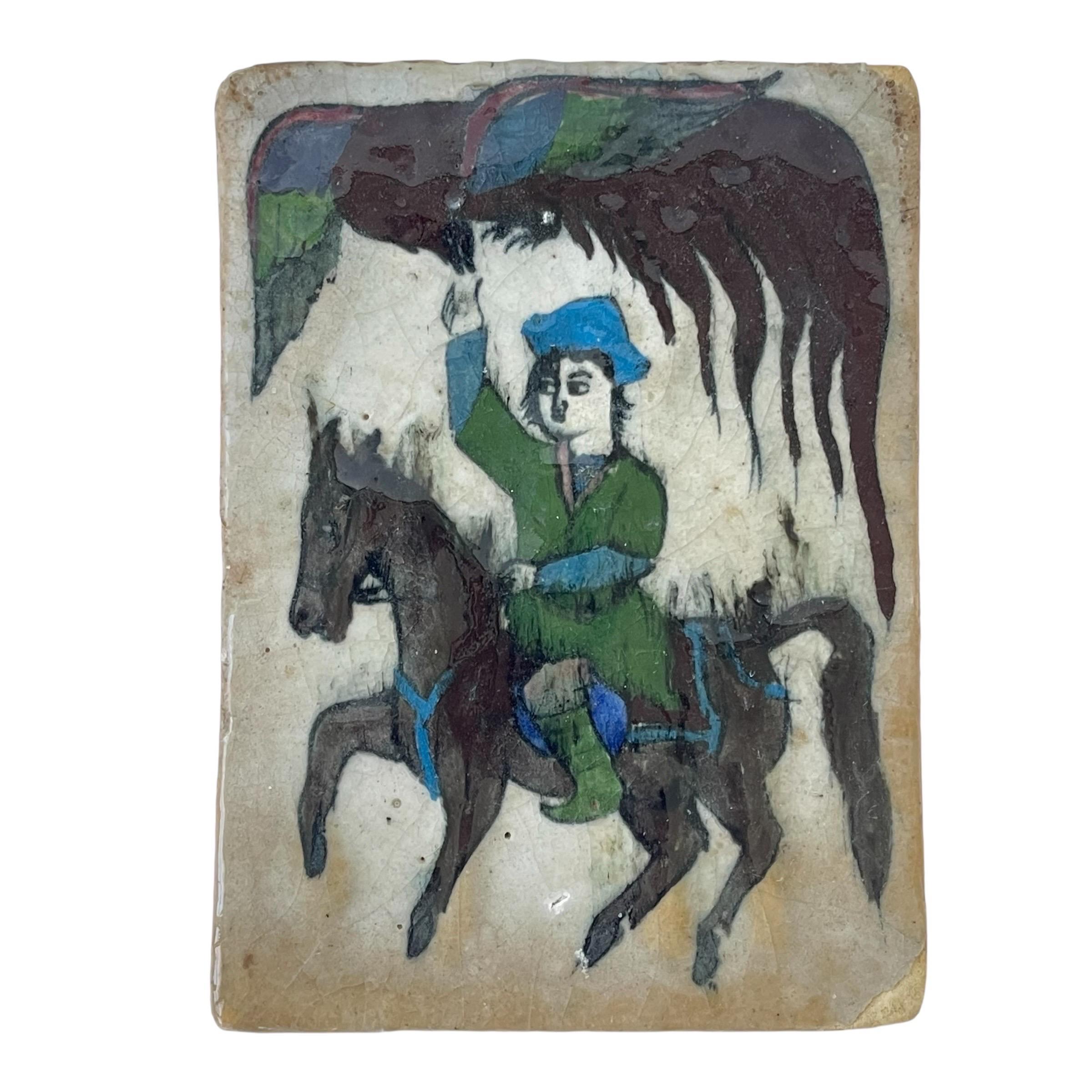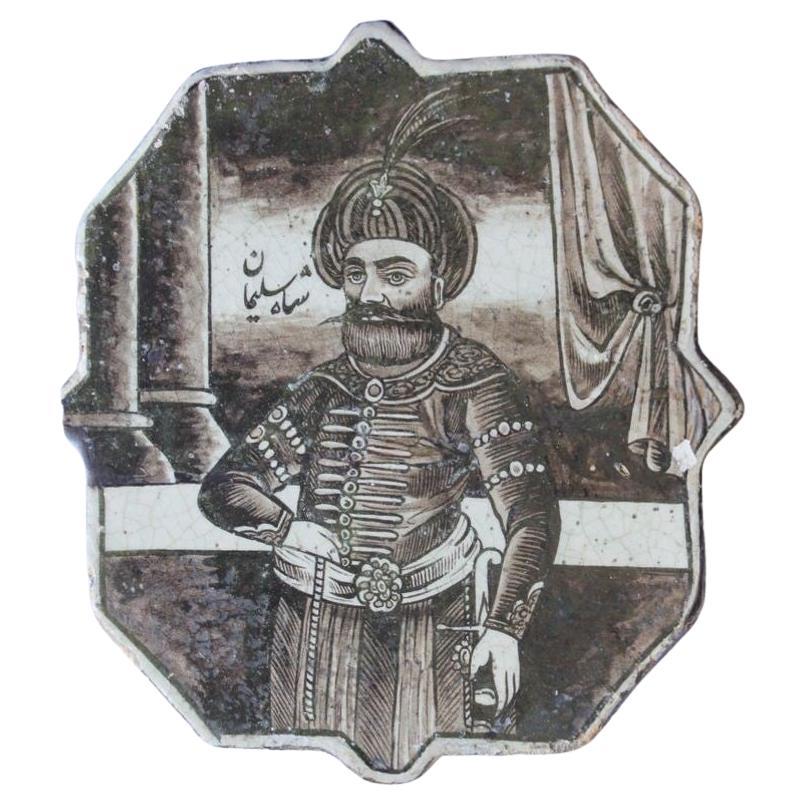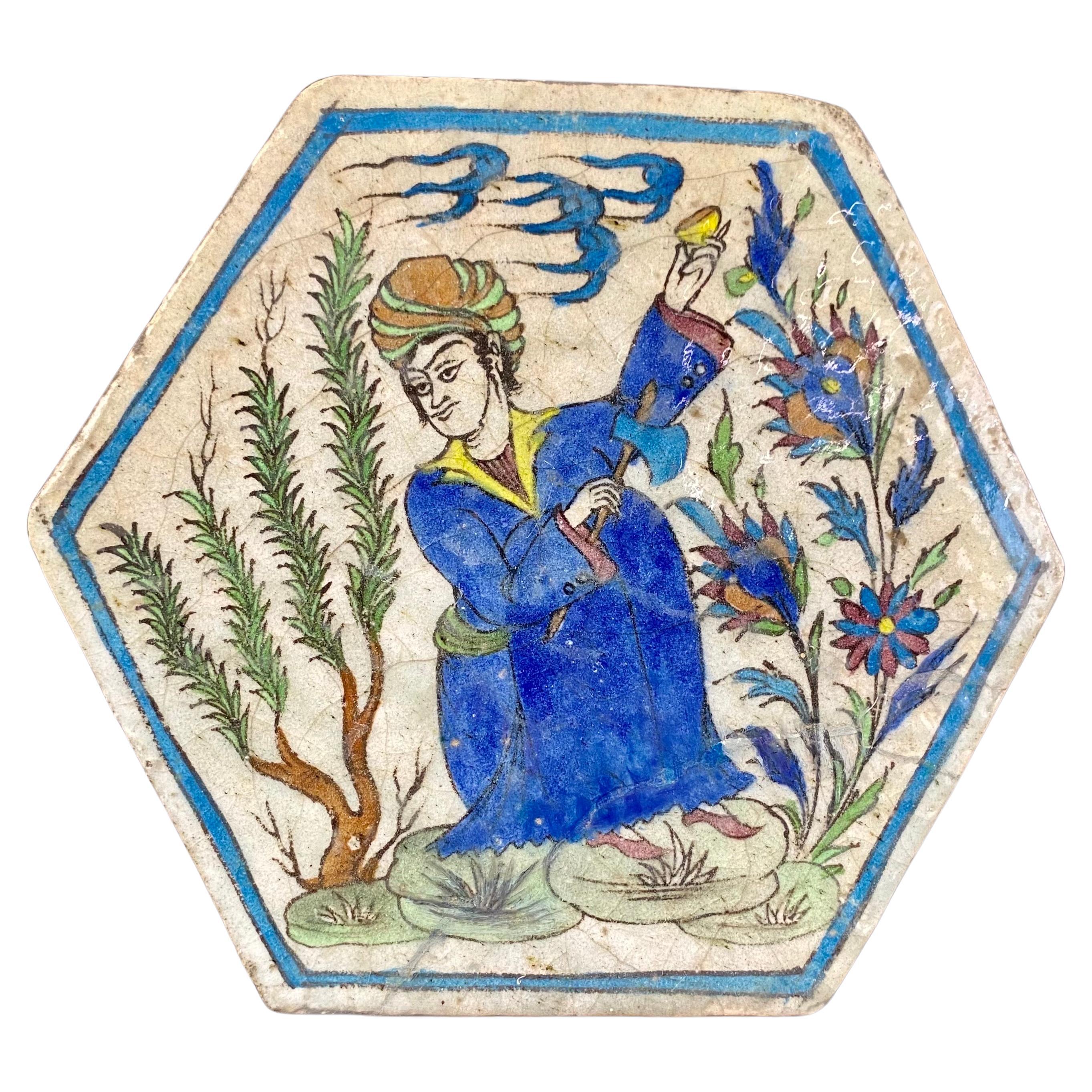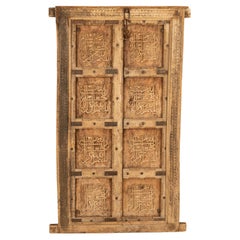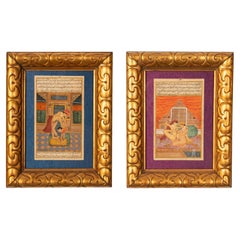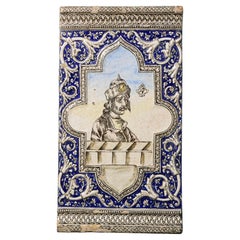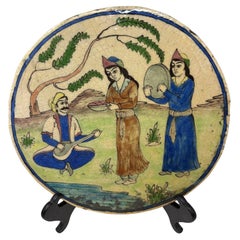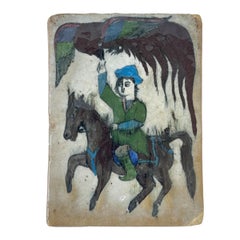Artículos similares a Antique 18th Century Persian Islamic Safavid Cuerda Seca Pottery Tile Rostam
¿Quieres más imágenes o vídeos?
Solicita imágenes o vídeos adicionales al vendedor
1 de 13
Antique 18th Century Persian Islamic Safavid Cuerda Seca Pottery Tile Rostam
1198,26 €
Acerca del artículo
Important Antique 18th Century Persian Islamic Safavid Cuerda Seca Pottery Tile depicting the legendary Persian hero Rostam, circa 1700.
The tile shows Rostam kneeling, wearing a tunic and a horned helmet, holding a scepter with deer-head finial, Rostam is kneeling under a garland festooned arch, with a falcon on a perch & a flowering urn. The background of the tile is cobalt blue with a lighter blue to the top & base, the tile is also decorated with hues of mustard, green, brown and pink. The tile is housed in a 19th century japanned wooden frame, condition is very good no damage or restoration, this rare Cuerda Seca tile is ready to hang on your wall.
Rostam or Rustam was a legendary hero in Persian mythology, the son of Zāl and Rudaba, whose life and work was immortalized by the 10th-century Persian poet Ferdowsi in the Shahnameh, or Epic of Kings, which contains pre-Islamic Iranian folklore and history. However, the roots of the narrative date much earlier.
In the Shahnameh, Rostam and his predecessors are Marzbans of Sistan (present-day Iran and Afghanistan). Rostam is best known for his tragic fight with Esfandiyār, the other legendary Iranian hero; for his expedition to Mazandaran (not to be confused with the modern Mazandaran Province). He is also known for the story of his Seven Labours.
Rostam was always represented as the mightiest of Iranian paladins (holy warriors), and the atmosphere of the episodes in which he features is strongly reminiscent of the Parthian Empire.
He rides the legendary stallion Rakhsh and wears a special suit named Babr-e Bayan in battles.
Tile size without frame 8" X 5.50"
- Dimensiones:Altura: 30,48 cm (12 in)Anchura: 22,86 cm (9 in)Profundidad: 2,54 cm (1 in)
- Estilo:Islámico (Del período)
- Materiales y técnicas:Alfarería,Glaseado
- Lugar de origen:
- Época:finales del siglo XVII
- Fecha de fabricación:Circa 1700
- Estado:Desgaste acorde con la edad y el uso. Very good antique condition.
- Ubicación del vendedor:Portland, OR
- Número de referencia:Vendedor: BB-83331stDibs: LU4876145433292
Sobre el vendedor
5,0
Vendedor Platino
Vendedores premium con una calificación de +4,7 y tiempos de respuesta de 24 horas
Establecido en 2000
Vendedor de 1stDibs desde 2019
424 ventas en 1stDibs
Tiempo de respuesta usual: <1 hora
- EnvíoRecuperando presupuesto…Envío desde: Portland, OR
- Política de devolución
Partes de esta página se han traducido automáticamente. 1stDibs no puede garantizar la exactitud de las traducciones. El inglés es el idioma predeterminado de este sitio web.
Garantía de autenticidad
En el improbable caso de que haya algún problema con la autenticidad de un artículo, ponte en contacto con nosotros en un plazo de 1 año para recibir un reembolso total. DetallesGarantía de devolución de dinero
Si tu artículo no es como se describe, sufre daños durante el transporte o no llega, ponte en contacto con nosotros en un plazo de 7 días para recibir un reembolso total. DetallesCancelación dentro de las 24 horas
Tienes un período de gracia de 24 horas para reconsiderar tu compra, sin preguntas.Vendedores profesionales aprobados
Nuestros vendedores de primera clase deben cumplir estrictos estándares de servicio para mantener la integridad de nuestros anuncios.Garantía de igualación de precios
Si encuentras que un vendedor publicó el mismo artículo por un precio menor en otro lado, igualaremos ese precio.Entrega global de confianza
Nuestra red de transporte de primera ofrece opciones de envío especializado en todo el mundo, que incluye envío personalizado.Más de este vendedor
Ver todoAntiguo Plato de Cerámica Iznik Kutayha Otomana Islámica del Siglo XVIII Turquía 1750
Buen plato antiguo de cerámica otomana Iznik/Kutayha del siglo XVIII, hacia 1750.
Plato con fondo de esmalte crema, pintado a mano con motivos florales multicolores de color azul, ve...
Categoría
Antiguo, Década de 1750, Turco, Islámico, Cerámica
Materiales
Alfarería
Antiguo Siglo XIX Árabe Marroquí Islámico Caligrafía Árabe Puerta Ventana 1850
Un buen par de antiguas puertas o contraventanas marroquíes de madera dura, talladas con caligrafía islámica, hacia 1850
Las puertas están alojadas en su marco tallado original, y ca...
Categoría
Antiguo, Década de 1850, Marroquí, Islámico, Puertas y portones
Materiales
Hierro
Antiguo Par Siglo XVIII Pinturas Hindúes Eróticas en Miniatura del Kamasutra 1750
Pareja de pinturas antiguas indias del Kamasutra erótico del siglo XVIII de gran calidad, hacia 1750.
Las pinturas, probablemente del nordeste de la India o posiblemente de Nepal, es...
Categoría
Antiguo, mediados del siglo XVIII, Indio, Angloindio, Pinturas y biombos
Materiales
Pintura
Antiguo candelabro islámico hispano-morisco de cerámica de reflejo metálico mameluco nazarí 1870
Por The Cantagalli Workshop
Increíblemente raro/único y monumental candelabro antiguo de cerámica islámica mameluca/nasrid de reflejo metálico, hacia 1870.
Este increíble candelabro de cerámica sigue la forma ...
Categoría
Antiguo, Década de 1870, Español, Islámico, Candeleros
Materiales
Cerámico
10.675 € Precio de venta
Descuento del 30 %
Antiguo azulejo de cerámica Kütahya Icono armenio Virgen María y Niño Jesús Turquía 1820
Importante azulejo icono de cerámica de Kütahya del siglo XIX con la Virgen María y el Niño Jesús, Turquía, hacia 1850.
Lo más probable es que el azulejo se fabricara para la comunid...
Categoría
Antiguo, principios del siglo XIX, Turco, Otro, Cerámica
Materiales
Alfarería
Antiguo Cuenco Chino de la Dinastía Qing 1644-1911 Esmaltado sobre Cobre Plato de Cloisonné
Fino cuenco chino antiguo de cloisonné de la dinastía Qing (1644-1911), hacia 1880.
El cuenco está finamente decorado con cloisons dorados en espiral sobre fondo de esmalte negro; en...
Categoría
Antiguo, Década de 1880, Chino, Qing, Metalistería
Materiales
Cobre, Esmalte
También te puede gustar
Gran azulejo islámico de cerámica persa Qajar del siglo XIX
Raro azulejo islámico grande de cerámica persa Qajar del siglo XIX.
A gran escala, está pintado con la efigie de un príncipe persa dentro de una cartela perfilada flanqueada por fo...
Categoría
Antiguo, Mediados del siglo XIX, Persa, Arte decorativo
Materiales
Cerámico
Azulejo de cerámica turco otomano islámico antiguo 1880
Antiguo azulejo turco otomano islámico del siglo XIX pintado a mano.
Figura pictórica de un sha Solimán en un palacio ante una columnata y una cortina.
Escritura árabe en la esquina ...
Categoría
Antiguo, siglo XIX, Turco, Islámico, Cerámica
Materiales
Cerámico, Alfarería
Antiguo azulejo decorativo circular persa Qajar
Antigua placa de azulejos islámicos persas Qajar de Oriente Medio del siglo XIX o antes.
Azulejo morisco asiático de cerámica esmaltada que representa una escena al aire libre con un...
Categoría
Antiguo, Fines del siglo XIX, Asiático, Islámico, Cerámica
Materiales
Cerámico
Antiguo azulejo persa Qajar de arcilla vidriada hecho a mano, Irán, circa 1900
Por L’atelier Arman Safavi
Antiguo azulejo persa Qajar, hecho a mano en cerámica de arcilla con esmalte aplicado a mano con una escena de un cetrero a caballo, Irán, Circa 1900s
Categoría
siglo XX, Persa, Islámico, Elementos arquitectónicos
Materiales
Arcilla, Pintura, Cerámico
Azulejo de cerámica turco otomano islámico antiguo
Antiguo azulejo turco otomano islámico del siglo XIX pintado a mano.
Figura pictórica de un sha Solimán en un palacio ante una columnata y una cortina.
Escritura árabe en la esquina ...
Categoría
Vintage, Década de 1920, Turco, Morisco, Cerámica
Materiales
Cerámico
Azulejo hexagonal de barro pintado a mano - Período Qadjar Kadjar - Asia
Azulejo hexagonal Kadjar de loza esmaltada pintado a mano y decorado con un personaje con vestimenta tradicional azul y turbante naranja y verde, que sostiene un hacha y un incensari...
Categoría
siglo XX, Asiático, Antigüedades
Materiales
Fayenza, Loza de barro
